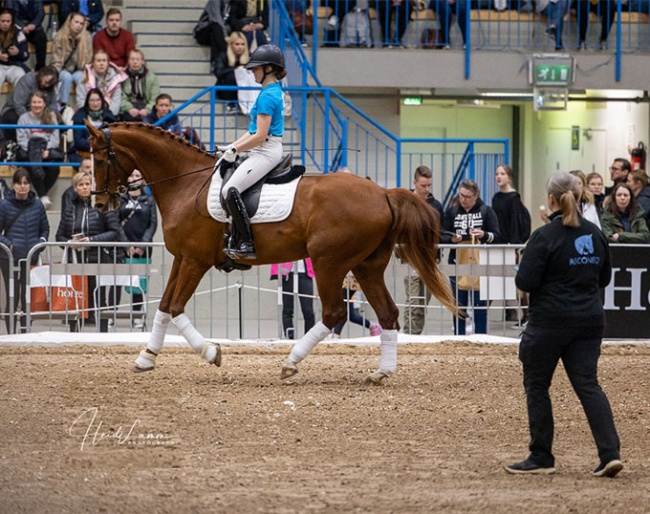
-- by Niina Kirjorinne - Photos © Heidi Lammi
I recently gave a dressage clinic in Finland at Tampere horse fair, which is one of the biggest equine events in our northern country. In this clinic I wanted to give the audience tools to recognize and correct most common issues in training ergonomics – the frame, contact and balance of the horse. These are usually assumed to take a long time to correct, and problems in these elements tend to travel along the daily training for quite a long time.
The demo rider was U25 rider Wilma Erkkilä with a 7 year old mare Xcelent Gem (Don Laurie x Lord Sinclair). This mare has been started rather lately and has been ridden for 1,5 years, so we were able to demonstrate a very typical young horse phase. On this clinic, I had equipped the horse with a rein pressure meter and a light that shows the different angles of the head, to help the audience understand the effects of different situations and exercises. In my work I use my mobile movement lab equipment to analyse different exercises and I wanted to give the audience a chance to take a peek into this point of view too.
Build the confidence and relaxation
At first, it’s important to find the calm and focused feeling by doing easy exercises when we enter a bigger arena with a young horse. I wanted to see that the rider can start a good, relaxed conversation with the horse in walk, trot, and canter on large curved lines and some easy lateral movements. For trust and confidence we need a soft and light contact, a connection that doesn’t restrict the movement. This can be checked already in walk, as the walk mirrors the quality of contact. Contact problems are created of tension, and any tension affects the walk immediately. For confidence, we also need a posture that allows the movement flow through the body. Good movement feels easy, relaxed yet powerful.
The frame always affects the balance

push becomes more difficult for the horse.The effect
of this is also seen in the rhythm and balance of
the trot.
Closing the frame behind the vertical for any reason affects the whole body, balance, and even movement strategies. If you look down, it gets more difficult to create an easy up and forward feeling. It also affects the horses vision field and the airways. The eyes feed information to the vestibular system, which monitors the balance of the horse. If you try to look forward and then lower your chin towards your chest, like looking down at your phone, you can certainly feel the tightening in your throat, jaw and neck. How could this be helpful in creating good, relaxed movement?
If the horse avoids the contact by lifting the head, we don’t want to take the head down, as this harms the trust to the contact very easily. Taking the head down with the hand or gadgets creates horses that tend to avoid the contact by moving both behind the vertical, and up in the air by lifting the head again whenever possible. If the horse seeks his head up, it’s more useful to maintain a soft contact, guide the horse to gently look to the side and then just activate the movement and give a tiny bit rein so the horse can seek the contact by reaching a little forward himself in an active, relaxed natural roundness that creates lift without getting too long in the neck. This takes only seconds, but requires repetitions.
The explanations

horse. The nose is slightly in front of the vertical, never close
the frame behind this line.
If we don’t correct this habit in an early phase, we train the horse to move in a bad posture and balance, training muscles and areas that might not be useful for the ergonomic use of the body. If we open the frame gently whenever needed, even with a young horse, this problem disappears quickly, and we can focus better on training the different exercises in better balance.
Make the training interesting for the horse

as soft contact as possible, then gently suggest
a lateral flexion or slight bending and ride forward again..
Let’s get curious in correcting the usual problems the moment we face them, even if it might take a few minutes, days or weeks to get an unexpected suggestion, like closing the frame or not responding to the leg corrected before it ends up being a habit. This helps a lot in a later phase, and I am sure this makes the daily training so much more logical for the horse.
-- by Niina Kirjorinne
Related Links
Functionality in Equitation: Reaching to the Bit
Functionality in Equitation: The Quality of Rein Contact Starts with Balance
Functionality in Equitation: Look At The Mouth